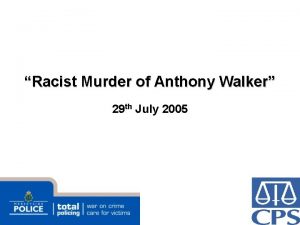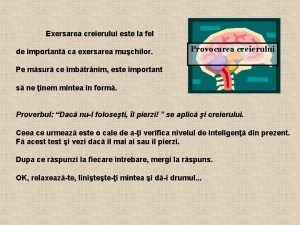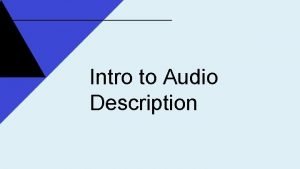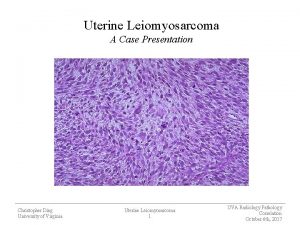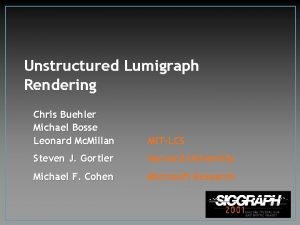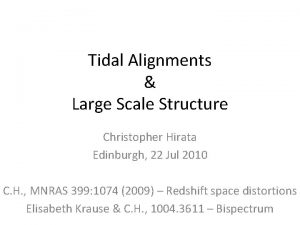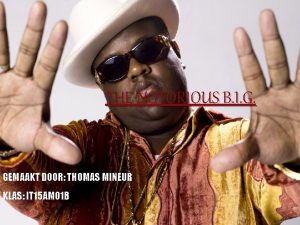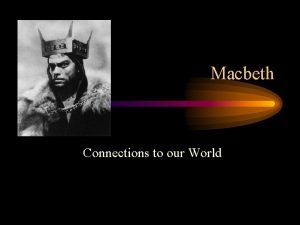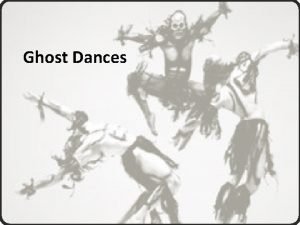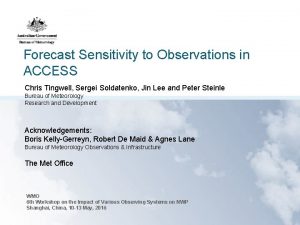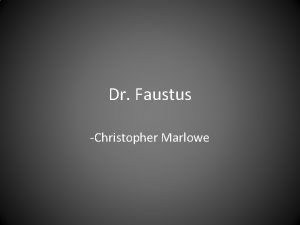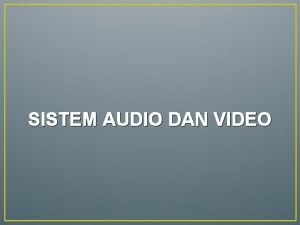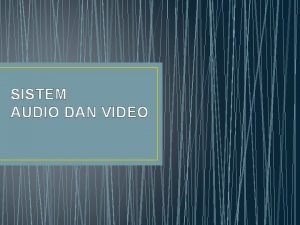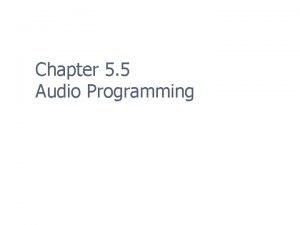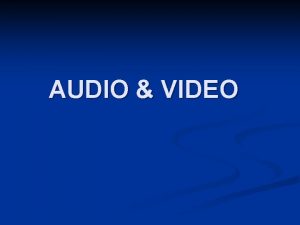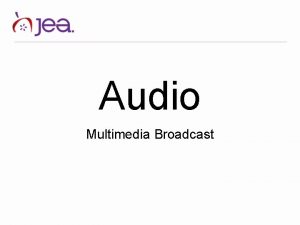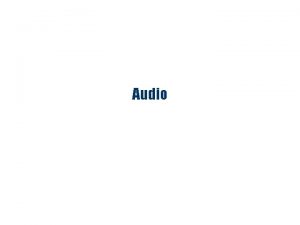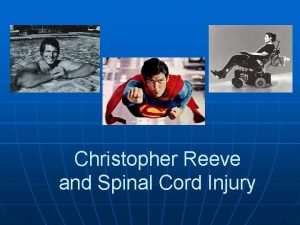An Introduction to Audio Description Christopher Delano Audio


























- Slides: 26

An Introduction to Audio Description Christopher Delano Audio Description Coordinator

Your Presenter Christopher Delano is an Audio Description specialist. He earned a degree in Theatre Arts and English at Columbus State University. His background in writing and criticism of dramatic and poetic literature has led to publications in the area of literary art. Christopher served for a number of years in a student support position at Columbus State University before joining CIDI. He has passion for providing necessary accommodations to all students, and has channeled that passion into the work he does today. Christopher and his description team have attended trainings in Audio Description with the LEAD conference at the Kennedy Center and through Joel Snyder.

CIDI’s Captioning and Described Media Team • Provide live remote captioning for classroom sessions, meetings, conferences, and events such as commencement ceremonies. • Create accessible and high quality captions for post-production video media. • Provide a complete Audio Description service, including initial researching of video content, writing scripts, recording audio with human voice actors, editing audio for clarity, and adding the final audio recordings to video content. • Prepare trainings and presentations (just like this one).

Audio Description – What Is It? “Audio Description involves the accessibility of the visual images of theater, television, movies, and other art forms for people who are blind, have low vision, or who are otherwise visually impaired. . . Audio Description is commentary and narration which guides the listener through the presentation with concise, objective descriptions. . . ” • From the American Council of the Blind – http: //www. acb. org/adp/ad. html

Audio Description Example – Frozen Disney's Frozen - Trailer with Audio Description

How Did We Get Here? • 1974: Gregory Frazier developed concept of Audio Description. • 1982: Metropolitan Washington Ear hosts simulcast of AD for American Playhouse on radio reading services. • 1987 -1988: WGBH pre-recorded Audio Description for American Playhouse productions broadcast using SAP for first time. • 1992: WGBH takes lead on AD for first-run films nationwide. • 1998: Section 508 of Rehabilitation Act requires AD on federal agency media. • 2008: Described and Captioned Media Program publishes its Description Key, guidelines for captioning and the description of educational media. • 2017: The Section 508 refresh requires WCAG 2. 0 Level AA adherence, which includes Audio Description (1. 2. 5).

Educational Audio Description • Consider the educational goal of the video and use that as a guiding factor in choosing description. • For example, the same video can be shown in several classes with different goals in each—identify the goal for this use. • Prioritize information over aesthetics. • Time is limited, so educational elements should be described before entertaining or artistic elements. • Exclude unnecessary and confusing description. • Information overload and description fatigue can ruin the experience. • Trust the listener’s ability to comprehend the material. • Do not condescend, patronize, or talk down to listeners.

How Do I Know I Need AD? • Obvious: Important visual information is presented without spoken description. • Title images, charts, graphs, et cetera. • Any movements or actions that affect or influence the scene. • Names and titles. • Less Obvious: Visual information that enhances the information is presented without spoken description. • ”B-Roll” footage that shows the concepts in action. • Costuming or other physical characteristics that influence perceptions, such as uniforms and cultural features.

The Audio Description Tests Closed-Eye Test In this test, you would “watch” the video with your eyes closed, then make notes about what elements of the video were hard to understand without visuals. If you find that there audio elements that confuse you without the visual, the video will need description. Audio-Off Test In this test, you watch the video without the audio and make notes of what are the most interesting and engaging visual elements. Then, watch the video again. If the most interesting visual elements are not explained or described, the video will need description.

Post-Production AD Considerations • Time • • Cost • • Voice • Post-production AD is going to take time to create, anywhere from a week to two months depending on the length and complexity of the video. Add it into your production timeline. There’s no way around it: AD can be expensive. Some AD creators choose to use synthesized speech while others will use human voice actors. • Delivery • • • Separate audio track. Timed-text track. Extended description or un-extended description on separate video.

How to Approach Adding Audio Description As-Needed Post-Production • Add AD to videos only when a need has been brought to your attention. • Gives much needed access. • Can cause delays in access to video by client. • Budgeting may not have been done. Planned Post-Production • Add AD to videos before release, but after they’ve been made. • Creates accessible content for any future client. • Costs should be accounted for in initial budgeting. • Need may never arise.

How to Get Post-Production AD 1. In-House Team • A dedicated team at your organization trained on proper description practices and equipped with the skills to record and edit descriptions. 2. Contract Vendor • A service provider agrees to complete your audio description, usually offering a fast turnaround and reduced price in exchange for a commitment to deliver a large number of videos. 3. CIDI • Membership based, à la carte ordering system.

Pre-Production AD Considerations During Concepting and Creation • Work closely with the scriptwriter to insert AD into the narrative. • Plan for what visual elements need to be shown versus what can be removed to reduce confusion. During Production • Allow text and graphics to remain on screen for longer period of time. • Give space between speakers so there is time for description. • Avoid loud background music.

How to Work AD Into Your Script When creating the script for a video—or even when presenting without a script— do not consider any visual element to be a “given. ” You will have viewers, clients, audience members, and more who can not or do not see the visual information. If a visual element is present, describe it with these considerations: 1. Content • For charts and graphs, describe trends and important figures, but avoid overload. 2. Context • • Where is it located? If it’s moving, how and where? 3. Aesthetics • What color is it? What shape is it?

Other Ways to Make Your Content AD-less • Introductions • Introduce yourself and your speakers. • Reading Text • Always read the full text that you are displaying. • If the text you are displaying is too much to read, consider making cuts. • Avoid Clip Art • The more you add, the more you describe. • Images can be confusing and distracting.

How to Host Audio Description Online • WCAG guidelines advise hosting a separate video with extended description so to allow users to choose which version to view. • You. Tube hosting allows for videos to be made private or unlisted. In Person • Presenting the described video to all audience members is good for access if described video contains captions. • You can also offer an audio recording of descriptions to play simultaneously with video.

Simplicity in Audio Description “Before you leave the house, look in the mirror and take at least one thing off. ” — Coco Chanel

Audio Description Practice Look at the image on the right. Describe it how you believe an audio describer would describe it.

My Description An older man holds an air horn outside of a home. Text reads “Jeff Foster: Tired of Birds. ” The Weather Channel logo appears in the lower right.

Practice Video Description Princess Mononoke - Calm Your Fury (First 15 seconds)

My Video Description Ashitaka, carrying a bow, rides his galloping red elk through the forest. A monster crashes through the trees pursuing him.

So Why is My Description so Short? When writing this description, I considered these to be the key factors: • Names: In this case, the boy’s name is Ashitaka. • Location: The forest. • Context: Down a hill, or toward the town; on the back of a red elk; away from a monster. • Details: Carrying a bow. • Descriptors: Quickly; closely.

Writing My Concise Description My original text: “Ashitaka, carrying a bow, quickly rides down a hill in the forest on the back of a red elk away from a monster. ” This description is clear, but it is also wordy and long. Let’s identify some of the areas of improvement. 1. 2. 3. It does not convey the urgency of the scene. The spatial context is cluttered in one spot of the sentence. There are too many thoughts in one sentence. By splitting the description into two sentences, we could more cleanly formulate a description. Cutting the adverb “quickly” and instead using a more vivid adjective in “galloping” brought more intensity into the scene. The spatial context of “down a hill” was unnecessary. The second sentence gives action and urgency by using words such as “crashes” and “pursuing” instead of “away from. ”

Considering Educational Content of this Clip Consider the video as if it is being shown in these different contexts: • • A Japanese history class focused on 1500 s Japan. An animation class. A course on fashion in Japanese animation. A history of animation class. What would you describe differently in these different contexts? How would you describe things differently if the class is about Japanese history versus animation history?

Questions?

Resources • DCMP Description Key • Listening is Learning • CIDI • LEAD Conference and Training
 Audio description training
Audio description training Direct to indirect speech
Direct to indirect speech Anthony delano walker
Anthony delano walker Franklin delano roosevelt amante
Franklin delano roosevelt amante Audio description lawsuits
Audio description lawsuits Christopher ding
Christopher ding Chris buehler
Chris buehler Christopher hirata
Christopher hirata Cma cgm christopher columbus
Cma cgm christopher columbus Notorious big thomas
Notorious big thomas Charlene gallego victims
Charlene gallego victims Devion christopher brooks
Devion christopher brooks Christopher p cannon
Christopher p cannon When did christopher columbus discover america
When did christopher columbus discover america Christopher dalley
Christopher dalley Livia soprano evil
Livia soprano evil We finally arrived at your destination
We finally arrived at your destination Christopher columbus sailed the ocean blue
Christopher columbus sailed the ocean blue Christopher hirata
Christopher hirata Ghost dances christopher bruce facts
Ghost dances christopher bruce facts Christopher tingwell
Christopher tingwell Christopher columbus achievements
Christopher columbus achievements Christopher janietz
Christopher janietz Scott kyle
Scott kyle Edward christopher sheeran
Edward christopher sheeran Dr faustus act 3 summary
Dr faustus act 3 summary Christopher geyer
Christopher geyer


